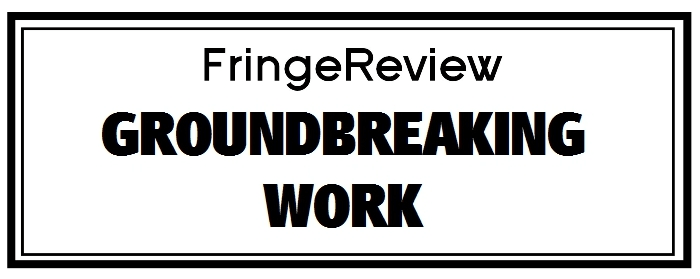Brighton Festival 2024
Lived Fiction
Stopgap

Genre: Ballet, Contemporary, Dance, Dance and Movement Theatre, International, Mainstream Theatre, Multimedia, Neurodiverse, New Writing, Storytelling, Theatre
Venue: Brighton Dome Corn Exchange
Festival: Brighton Festival
Low Down
“With a flex of an arm she seasons the air.” Though these words form part of the audio-commentary with subtitles by Stopgap’s Lily Norton, it’s exactly what this company’s Lived Fiction is about.
Featuring two wheelchair dancers and four non-wheelchair dancers, with Norton at a desk throughout, it arrives at Brighton’s Dome Corn Exchange in the Festival. Devised by co-artistic director Lucy Bennett it enjoys a single performance on May 14th.
Unique, spellbinding, groundbreaking; above all makes everyone more alive to the possibilities of being human.
Co-Artistic Directors Lucy Bennett and Laura Jones, Resident Choreographer Chris Pavla, Rehearsal Director Amy Butler, Community Engagement Artist Cherie Brennan, Assistant Producer/General Manager Annie-Rose Grantham, Photographer Chris Parkes.
It’s next at the Southbank on September 4th.
Review
“With a flex of an arm she seasons the air.” Though these words form part of the audio-commentary with subtitles by Stopgap’s Lily Norton, it’s exactly what this company’s Lived Fiction is about.
Featuring two wheelchair dancers and four non-wheelchair dancers, with Norton at a desk throughout, it arrives at Brighton’s Dome Corn Exchange in the Festival. Devised by co-artistic director Lucy Bennett it enjoys a single performance – its UK premiere – on May 14th. It’s next at the Southbank on September 4th.
Described as a sensual chorography and billed as 90 minutes with an interval it in fact runs for two hours. It’s a stunningly visual experience, and unlike several other productions from this company, it’s less story-led and more a showcase of stories: at its heart are three couples, exploring different ableisms and relationships. Though hetero-normative in one way, agency’s given to the women, and each dancer emerges as witness.
There’s touch-tours, people are invited to leave the theatre where necessary, and return, in relaxed-performance mode. There’s opportunity in the interval to meet some dancers, and many took this opportunity.
Each dancer introduces themselves in some playful blocking. Dancers form up or sub-divide, there’s teasing interplay of who gets to say what, or if they’re done yet. Two sets of orange chairs are, bar Norton’s desk, the only props. Dancers sit on or by them when others duet or solo. Stopgap are equality-led, and such weight is given to each dancer.
Lighting – and it’s not easy to find out who some creatives are – is mostly undistracting, suffusing the air. At some points though it’s striking, filleting the light and dark of the stage, apparating on bright dilated polka-dots of lemon and violet. These moments are sparing if virtuosic. A little more would have been entrancing.
The a capella singing and use of an organ in the sound design adds to a sacramental moment, but if this is holy theatre in Peter Brook’s term, it’s inclusively secular and non-specific.
After the Introduction, there’s an ensemble Soft Shoe Shuffle, keyword being harmony.
Some phenomenal dances are performed by Cambodian wheelchair dancer Nadenh Poan (also a resident choreographer), standing on his head at one point, wheelchair gently spinning. Voiceover Dan moves us to ‘Tight Textures’ in more snaky elemental shapings, and we move into Poan’s dancing, or as termed here the “mechanics”.
Each of these dancers though finds a maze of narrative though a gentle pressure of difference.
Poan’s duet with Emily Lue-Fong ‘Ancient Ammonites’, is the first show-stopper: as she gently walks on him as a bridge, enfolds and echoes his body with hers and – this word repeated – “unfurls” after spellbinding intimacy. It’s the first of three duets, and ends the first act on a hushed high.
In the second act, Tipping Trio has Poab, Noth and Brinkow – all of whom have danced together six years – enacting a rehearsal, all stop and start, literally displaying the iridescent strands of choreography as it’s put together.
‘Gods and Men’ introduce the second duet: Christian Brinklow and the other wheelchair dancer, Monique Dior Jarrett, playing with ‘size and power’ letting the energy of one flow to the other, in Norton’s voice-over describing the poetics as we watch the lift-off.
That’s echoed with Jannick Moth and Hannah Sampson who lives with Downs Syndrome, in their ‘An Undisturbed Lion’ and again the power of attraction – Sampson’s hip-action is repeatedly referenced. There’s a surprise though, one of those moments breaking even those conventions set up.
Sampson narrates as opposed to Norton telling in “I’m in A Room’, and the “show and tell” – words we end on – have been present all along: though sometimes in different voices. Voice-overs of some of the dancers take up from where Norton leaves off.
After, we return to Poan’s Act One dance now transfused through other dancers in ‘Translated’, one “as if catching grain” as yellow light suffuses the act of a prone dancer like something out of one of theatre director Yael Farber’s productions. ‘The Last Dance’ reflects how far the world’s being shifted by such agency, and our own witness.
Pace is even; and though undulating, hypnotic. Words projected on the screen are nicely kerned, though too small. Norton’s delivery and pre-recorded voices are clearer enough and there’s no other distraction.
There’s no need to underscore how groundbreaking and gifted these dancers are. What’s difficult to convey is quite how exquisite and detailed dancing is; and – bar snippets – the gorgeous language entwined with it.
There are moments where pace dictates a length, and had this been 90 minutes with an interval as billed, or even 100, it would be perfect. Though lighting can distract, a little more of the stunning visuals we did get would also vary the show’s affect.
That aside, catch it at the Southbank on September 4th if you’re in the least attuned to this marvellous aesthetic. It’s unique, spellbinding, groundbreaking; above all makes everyone more alive to the possibilities of being human.


















































